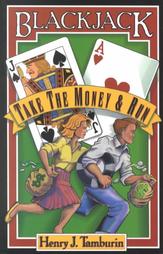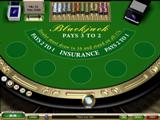
Blackjack: Take The Money and Run

When the Going gets Tough at Blackjack
You are sitting at a blackjack table and the dealer gives you a 2,5 and his face card is a 6. You hit, and draw an Ace. This gives you a soft 18 (2, 5, A). You can’t double down because you’ve Henry Tamburin is the editor and publisher of the Blackjack Insider Newsletter and author of the best-selling Blackjack: Take the Money & Run. He is also the lead Instructor for the Golden Touch Blackjack course, a feature writer for Casino Player magazine (and 6 other publications); an owner of a casino gambling publishing company (www.rsucasinobooks.com) and the host of www.smartgaming.com. For a free three month subscription to the Henry's Blackjack Insider Newsletter with full membership privileges go to www.bjinsider.com/free. Henry's website is www.smartgaming.com already drawn a third card. So how would you play the hand?
Henry Tamburin is the editor and publisher of the Blackjack Insider Newsletter and author of the best-selling Blackjack: Take the Money & Run. He is also the lead Instructor for the Golden Touch Blackjack course, a feature writer for Casino Player magazine (and 6 other publications); an owner of a casino gambling publishing company (www.rsucasinobooks.com) and the host of www.smartgaming.com. For a free three month subscription to the Henry's Blackjack Insider Newsletter with full membership privileges go to www.bjinsider.com/free. Henry's website is www.smartgaming.com already drawn a third card. So how would you play the hand?
This is just one of several blackjack plays that always cause players to have fits. But there’s no need to panic. Read on and learn how to play these and other tough blackjack hands like a pro.
Three-card soft handsIf you have a three-card soft hand and can’t double down, here’s how to play it. If you have anywhere between a soft 13 and a soft 17 hand, always hit no matter what the dealer shows. If you stand on these soft hands, you will be making a big mistake that will cost you money. If you hold a soft 18 and you can’t double down, then you should stand if the dealer’s face card is 8 or lower, and hit if it’s 9, 10, or an Ace. Always stand on soft 19 and soft 20, no matter what the dealer shows.
Pair of 8s versus dealer 10
Most players cringe when they are dealt a pair of 8s against the dealer’s 10 face card. Their ‘feelings’ tell them they should not split because a pair of 8s against a 10 is a losing hand. They figure: ‘Why put out more money by splitting and risk losing twice as much?’The books say to always split 8s even against a dealer’s 10 face card. Yes, you will still have a losing hand when you split, but in the long run you will lose less money versus hitting or standing on the pair of 8s.
The reality of the situation is that being dealt a 16 against a dealer’s 10 is the worst possible hand you could get in blackjack. You will lose money with that 16 but when the 16 is a pair of 8s you have a chance to lose about 50 per cent less money over the long term when you exercise the option to split the 8s. You won’t be turning a losing 16 hand into a winner. Rather, over time you will be cutting your losses and saving some money by splitting 8s against the dealer’s 10.
Time for insurance?
This is a really tough play for most blackjack players. You are finally dealt a blackjack hand and, would you believe it, the dealer’s face card is an ace. In this situation, the casinos make you a proposition you can’t lose on.
They’ll give you an even money pay-off right on the spot, even before the dealer checks their hole card to see if they have a blackjack hand. Who can resist winning even money? After all, a bird in the hand is worth more than two in a bush.
But if you check the facts of insuring or taking even money on your blackjack hand when the dealer shows an ace, here’s the score: yes, you’ll get paid 1 to 1 every time you take even money, but in the long run you’ll average a 1.04 to 1 pay-off when you pass up the even money proposition. This is because most of the time the dealer will not have a 10 or picture card in the hole (and you’ll be paid 3 to 2 for the blackjack) versus the times they do have a 10 or picture card (known as a push). If you average out the number of times you push versus get paid 3 to 2, the maths shows an average payout of 1.04 to 1 – which, of course, is greater than the even money (or 1 to 1) pay-off you would get if you chose to take that. The bottom line is that you’ll win more money in the long run when you never insure or take even money on your blackjack hands.
Doubling for less
I see this play being made far too often by blackjack players. A player is on a roll and starts increasing his bets. They place a bigger-than-normal bet, say $20, and the dealer gives them an obvious double down play. They start to sweat, thinking about having to put out another $20 to double down. Maybe they shouldn’t double down but they know that’s against what all the books say. So instead they compromise and double down for $10 which is less than the initial $20 bet.
When the books say double down they do so for a reason. It’s because your expectation of winning money on the hand is greater when you double versus when you hit. But when a player doubles for less, they give up some of their potential profit. In essence you are not taking complete advantage of a favourable situation – not a smart way to play blackjack. Never double down for less.
Soft 18 against dealer’s 9
If the local casino called you up one day and said: ‘Listen, come and play blackjack with us and we’ll give you an automatic 18 on every hand,’ would you take up the offer? Most players would, but guess what? Over a long period of time you will end up a loser with that 18.
With a soft 18 you have the option of improving your hand by hitting. You should not do so every time, but enough to win about 45 per cent of hands when you do. If you stand, you’ll only win 40 per cent of the hands. The better play is therefore to hit when you are dealt a soft 18 and the dealer shows a 9.
Pair of 9s against a dealer’s 9 face card
This one fools a lot of players. It seems like standing on the 18 (9, 9) is the right thing to do against a dealer’s 9 face card rather than split and have a 9 against a dealer’s 9.
It turns out that if you stand you will lose 18 per cent of your bets but, if you split, you’ll lose just 12 per cent of your bets. Both plays are losers but you’ll lose less by splitting. Therefore the better play is to split 9s when the dealer shows a 9 face card.
There are several other tricky blackjack hands that often confuse players and I’ll cover them in a future article. For now, follow the advice in this article and you’ll take a big step in becoming a better blackjack player.

